Author
Czesław Głowacki, MD, Auschwitz survivor No. 4661, prisoner-doctor in the camp hospital, contributor to Przegląd Lekarski – Oświęcim.
The article below is one of pioneering studies into the criminal sterilisation experiments conducted in Nazi German concentration camps. For a more recent and up-to-date discussion of Clauberg’s criminal activities, the reader may want to watch the video recording of H.-J. Lang’s lecture a the 4th international conference Medical Review Auschwitz: Medicine Behind the Barbed Wire, as well of the lecture by Knut W. Ruyter’s lecture, exploring the subject of Clauberg from a more ethical angle. Both lectures were the bases of respective chapters in Medical Review Auschwitz: Medicine Behind the Barbed Wire. Conference Proceedings 2022: “Carl Clauberg’s forced sterilizations in Auschwitz. New findings from little-noticed original documents on the human experiments conducted in Block 10” and “Prosecuting evil: the case of Carl Clauberg. The mindset of a perpetrator and the reluctance and procrastination of the judiciary in Germany (1955–1957)” [Website Editor’s note].
One of the most prominent Nazi physicians who conducted criminal pseudo-medical experiments, inflicting a shocking amount of cruelty upon their helpless victims,1 and one of the most infamous founders of the inhuman medicine practised under the auspices of SS,2 was Prof. Carl Clauberg,3 who carried out procedures to determine efficient methods of mass sterilisation. Even today, quite understandably, those Nazi German atrocities evoke astonishment and horror, while the morals and mentality of SS physicians, their supervisors, and collaborators are inevitably exposed by their special efforts to invent simple but insidious methods of mass sterilisation, which could lead to the annihilation of the nations defeated and subdued by Hitler, in accordance with his racist policy of planned extermination.
As a gynaecologist, I became interested in the original SS medical records, that is the extant hysterosalpingograms4 from Auschwitz, which are absolutely unique documents made available to me by the Main Commission for the Prosecution of Nazi Crimes in Poland.5 These X-rays are part of the medical records kept by Clauberg to document the course of his sterilisation experiments, which he conducted personally on women prisoners.6
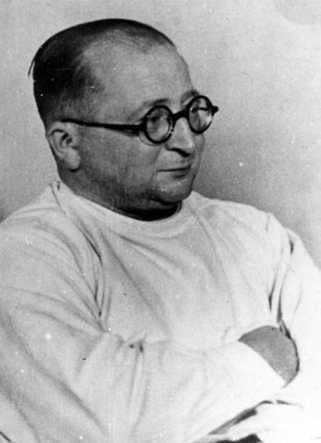
Photo 1. Prof. Carl Clauberg, member of the SS, perpetrator of cruel, criminal pseudo-medical experiments. Source: Przegląd Lekarski – Oświęcim, 1976. Click the image to enlarge.
Prof. Clauberg, whom I came to know as I am an Auschwitz-Birkenau survivor, was an exceptionally complex type of German bureaucrat and scientist, and at the same time an SS criminal. He was both a highly qualified research scientist specialising in modern medicine and a man completely devoid of human emotions and scruples. His crimes brought him a notoriety for causing indescribable suffering and pain to many women who were held in Nazi German concentration camps. He stood in the ranks of the pioneers of nihilistic medicine, which formed part of a new pseudo-science proposed by the Nazi Germans and called “negative demographics.”7 Germany implemented this policy in Auschwitz, openly proclaiming the end of deontology, ethics, and humanitarianism in the work of German doctors in the Third Reich8.
Carl Clauberg was born on 28 September 1898 in Wupperhof. He studied Medicine in Kiel, Hamburg, and Graz and graduated in 1924. He worked as an assistant in the Institute of Forensic and Social Medicine at Kiel University. In 1925 he obtained the doctor’s degree in Medicine and started work as an assistant in the Gynaecological and Obstetric Hospital headed by Prof. Schröder. Clauberg specialised in research on the sex hormones. In 1933 he was awarded the post-doctoral habilitation degree9 and was appointed docent.10 From 1934 he was a ward physician (Oberarzt) in Königsberg and his supervisor was Prof. von Mikulicz-Radecki.11 Clauberg was appointed an extraordinary professorin 1937 and an ordinary professor in 1939. He was regarded as an authority on hormone research. He developed the production methods for two hormone drugs, Progynon and Proluton, for the pharmaceutical company Schering-Kahlbaum, in which he held shares. Before the War, Clauberg’s papers on infertility, castration, and hormonal treatment were published in specialist journals. In February 1940 he was appointed head of the gynaecology ward in a miners’ hospital in Chorzów.12
In 1933 Clausberg joined the Nazi Party and the League of National Socialist Doctors. He arrived in Auschwitz on 20 August 1942, already in the rank of SS Gruppenführer (the SS equivalent of a general). His criminal experiments were conducted in Block 10 of the main camp.13 On 16 January 1943, when all the machinery and equipment had been installed in Block 10, he started his pseudo-medical experiments on women. In his opinion, the surest sterilisation method was to inject irritant substances into the uterus (he used a 5–10% solution of formaldehyde). He selected his subjects personally from a group of candidates who were healthy, regularly menstruating women aged 20–30, sexually mature and with the right anatomical build. Mothers, that is women with proven fertility, were “first choice” candidates. Clauberg’s victims were nationals of fourteen European countries, including Poland.14 The notes on the X-rays confirm what has been presumed so far, namely that Clauberg carried out his experiments in person.
Following a preliminary interview, the victim had to sit in a gynaecological chair. The doctor inserted a vaginal speculum and a tenaculum15 to expose the cervix. Next, a contrast agent, needed for the subsequent X-rays, and a formaldehyde solution were injected under pressure into the uterus, from where the fluids entered the Fallopian tubes. Clauberg was assisted by Dr Paul Edmund Göbbel,16 chief chemist of the Schering company, and Dr Maximilian Samuel,17 a gynaecologist from Kiel. To make the intrauterine injections, he [Clauberg] used Neo-Rontyum (dubbed Göbbel’s lotion), a substance which was supplied [by Goebel] but not in general use in radiology. The extant X-rays show that it was an oil-based contrast medium that posed a serious risk to the women’s lives, because if it entered the blood vessels or body cavities, it could give rise to an embolism (blockage).18
After the last injection, the victims stayed in Block 10 for 5–6 weeks under Clauberg’s observation. Afterwards, they had follow-up examinations and hysterosalpingography to check if the uterine tubes were still patent. If they were not completely blocked yet, the procedure was repeated using more concentrated liquids to close off the Fallopian tubes.19 The toxicity of contrast materials used in the X-ray examinations depended on their chemical composition as well as their physical and chemical properties. The contrast agents Clauberg applied in combination with formaldehyde during hysterosalpingography, when he injected them into the uterus at various pressures, as well as the frequent intravasation (as shown in the X-rays), always posed a threat to the victim’s life. It is known that when contrast agents pass into the circulatory system, they may cause a dangerous allergic reaction. A circulatory collapse caused by a shock over a broad intensity range may lead to death. The ultimate aim of Clauberg’s experiments was to induce chronic salpingitis, that is inflammation of the Fallopian tubes and their subsequent suppurative obstruction. Inflammation led to the destruction of the epithelial tissue lining the tubes, and the hair-like cilia would then stick together, partly or fully blocking up the Fallopian tubes.
The images taken after the intrauterine injections of formaldehyde show a mass of dense fibrous connective tissue with signs of infiltration and inflammation and many irregular cavities lined with simple columnar epithelium, that is remnants of the salpingian lining. In general, the lamina muscularis mucosae is atrophied and fibrous and the subserosal connective tissue is hyperplastic. In consequence of the uterine injections, usually the contrast media mixed with formaldehyde would travel from the Fallopian tubes and reach the peritoneum in the lesser pelvis, causing endomyoperimetritis, salpingo-oophoritis, and pelveoperitonitis.20
Clauberg’s experiments on women prisoners aroused great interest in the SS headquarters in Berlin, as they related to the Nazi plans for the biological extermination of entire nations. The course and results of Clauberg’s sterilisation procedures were closely followed, as shown in the correspondence between the staff of the SS Reichsführer21 and SS Standartenführer Helmut Poppendick,22 Reichsarzt for the SS and Police. In his letter of 30 April 1944 (Photo 2), Himmler asked Poppendick to conduct a statistical analysis of all the cases of sterilisation carried out using Clauberg’s method and to register the SS physicians sterilising women by this procedure.

Photo 2. Himmler’s letter to Poppendick concerning Clauberg’s experiments. Preserved in the microfilm collection of the Main Commission for the Prosecution of Nazi Crimes in Poland, Ref. No. 175, 175, R-49, fcl. 2562832. Reproduced after Przegląd Lekarski – Oświęcim, 1976.
The Main Commission for the Prosecution of Nazi Crimes in Poland23 holds twenty-six original hysterosalpingograms (HSGs), X-ray records of the criminal sterilisation of women in Auschwitz personally conducted and described by Clauberg, and gave me access to these materials. They are absolutely unique extant wartime documents of this kind. We have selected six out of the 28 for reproduction here (Photos 3–8), since they are particularly significant evidence of the criminal pseudo-medical experiments carried out by a doctor. At the same time, they are still fairly legible, even after having been processed for publication.
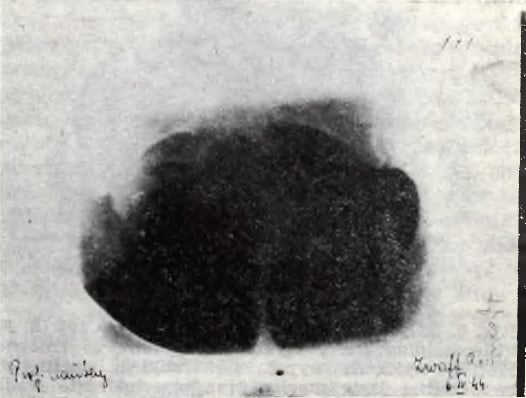
Photo 3. Image No. 2/171. The second HSG for Z.R., dated 6 April 1944. The uterus is completely filled with the contrast agent and the Fallopian tubes are obstructed. Reproduced after Przegląd Lekarski – Oświęcim, 1976.
The quality of these X-ray records testifies to the professionalism of the physician who made them. He was an expert in the field and used excellent X-ray plates made by AGFA. Technically, the HSGs are flawless. Various contrast agents were applied, including oil-based ones, which are particularly harmful if the uterus is damaged or if they reach the blood vessels, as they cause embolism (blockages). Such complications may be observed on the X-rays of E.F.24 The contrast agent is still present in the lesser pelvis, as shown in an image taken twenty-four hours after the injection, which means that it was either an oil-based medium or barium sulphate. The X-ray records were meticulously prepared, with a high degree of accuracy and technical precision. Follow-up X-rays were made after each HSG to check the contrast retention in the pelvis minor.

Photo 4. Image No. 3/171. The third HSG for Z.R., the same subject as in 2/171, dated 25 November 1944. The uterine cavity has been filled under pressure, and the Fallopian tubes are obstructed (the first image has not been reproduced for technical reasons). Reproduced after Przegląd Lekarski – Oświęcim, 1976
The HSG taken for Z.R.25 and reproduced in Photo 3, can be compared with the next (second and third) HSG images taken for her as follow-ups, which have been preserved. The follow-up X-rays were to demonstrate that the Fallopian tubes that had been patent prior to the procedure were occluded afterwards, and that Clauberg’s method worked.26 There were two follow-up examinations for the woman whose initial X-ray image was inventoried as No. 15426 (not reproduced here). The follow-ups were taken two and four months after the sterilising injection.
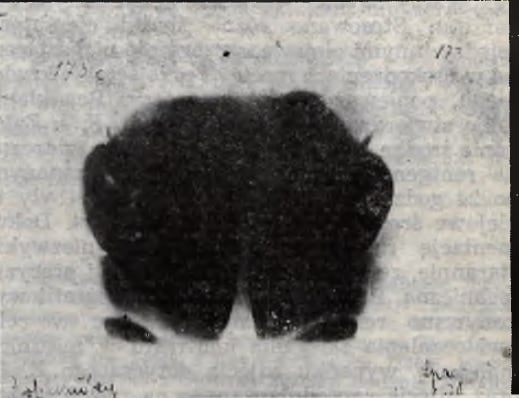
Photo 5 One of the HSGs for S.Z., No. 173, dated 6 April 1944. The uterine cavity has been filled completely, the Fallopian tubes are patent and some of the contrast agent has penetrated into the peritoneum. Reproduced after Przegląd Lekarski – Oświęcim, 1976
The experiments ran from February to November 1944. The majority of the HSGs were made in November 1944, shortly before the camp was liberated by Soviet troops. As many as five HSGs were taken on 25 November 1944, which shows that the researchers were highly skilled, because hysterosalpingography is a time-consuming procedure. Yet it was carried out routinely by an experienced team. Not only was Clauberg a scrupulous diagnostician, but he also wanted to check how useful various contrast materials were for hysterosalpingography and this is why as a rule, the X-rays were always made twenty-four hours after the injection. The documentation sometimes holds only a single HSG for a subject, made either prior to the sterilisation or afterwards, or taken for those women whose Fallopian tubes turned out to be blocked already so they were not qualified for the experiment on the basis of a single X-ray.27
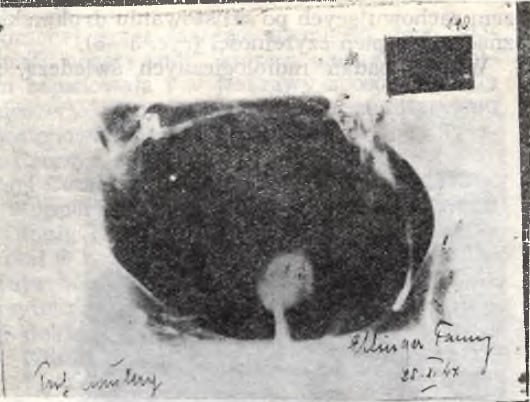
Photo 6 An HSG made for E.F., No. 190, dated 25 November 1944. The uterine cavity is deformed and filled with the contrast agent. Intravasation into the venous plexuses and trunks can be observed. Reproduced after Przegląd Lekarski – Oświęcim, 1976
The full set of radiological documentation shows that the technicalities of the experiment were thoroughly planned and that the doctor [who carried them out] had a lot of experience and conducted effective, though inhuman, research work on his women subjects. The plates were carefully described and provide both Clauberg’s name as well as the first and last name of the woman. They carry register numbers and the date of the experiment, and are now kept in the archives.
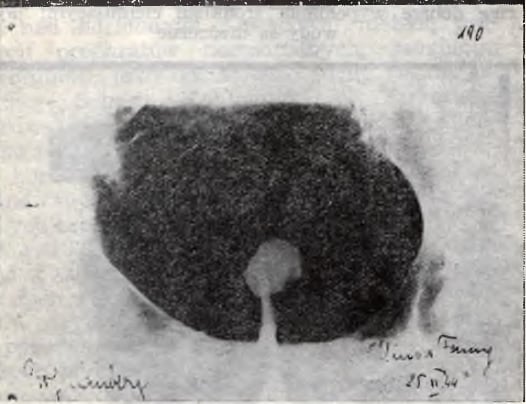
Photo 7. Another HSG made for E.F., No. 190, dated 25 November 1944. Three subsequent images were taken, showing the gradual passage of the contrast agent into the pelvic veins. Reproduced after Przegląd Lekarski – Oświęcim, 1976
It should be explained that when Auschwitz-Birkenau was liberated by Soviet forces, the documentation was discovered in the offices of the camp and the prisoners’ hospital. Some documents had been previously burned by the Germans, but the ones they did not have time to burn [and left behind] were secured by the Soviets and transported to archives in the USSR. In 1967 the original HSGs were handed over by the Moscow archives to the Main Commission for the Prosecution of Nazi Crimes in Poland.28 All of them are identical in size, 18 by 25 cm; some of them have the inscription “Agfa-Din-Sicherheitsfilm-safety” along the edge.
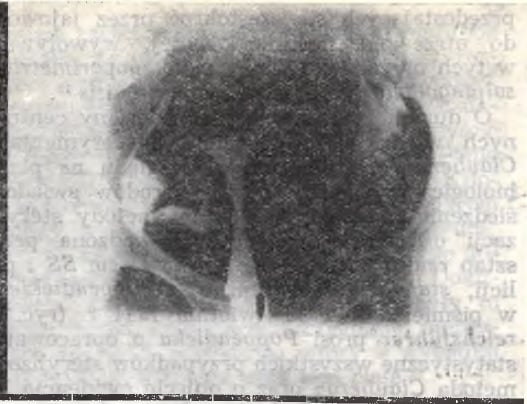
Photo 8. An HSG made for S.B., No. 138,41 dated 25 November 1944. This image shows the uterus and patent Fallopian tubes and a large quantity of the contrast agent which has penetrated into the peritoneum. Image No. 10/138, which is not reproduced here for technical reasons, was taken twenty-four hours later, on 26 November 1944, and shows a large quantity of the contrast agent in the peritoneum of the lesser pelvis. Reproduced after Przegląd Lekarski – Oświęcim, 1976
To confirm that the women’s names on the X-rays are authentic and that they were actually confined in Auschwitz, on 29 May 1967 the Main Commission for the Prosecution of Nazi Crimes in Poland sent an enquiry to the Auschwitz Museum. The Museum explained that the archives of the Nazi German concentration camp Auschwitz-Birkenau contain data concerning prisoner E.F. (whose full name was given): she arrived in Auschwitz on 20 July 1943 on an RSHA transport of Jewish people deported from the detention camp in Drancy, France. Her date and place of birth are known (15 February 1895, Kiev, Ukraine), but we do not know her registration number or her fate. The Museum also found that ten or so prisoners from the same transport were moved from the women’s sector of Birkenau to experimental Block 10 in Auschwitz I. The other six names listed in the letter sent by the Main Commission for the Prosecution of Nazi Crimes in Poland to the Auschwitz Museum were not found in the latter’s archives.29
Importantly, the information received from the Museum allowed the Commission to establish that the X-rays received from Moscow and sent to the Commission (and now kept by the Mechanical Documentation Section of the archives held by the Main Commission for the Prosecution of Nazi Crimes in Poland; inventory numbers 15426–15451) were indeed those of women prisoners of Auschwitz-Birkenau who had been selected by Clauberg for his guinea pigs. The numbers allocated to those women and shown on the plates are not identical with their camp registration numbers, neither do they indicate how many women fell victim to Clauberg’s experiments, but they simply give the order in which these subjects were experimented on in Block 10.30 The exact number of the victims of Clauberg’s criminal experiments is not known. The documents held by the Main Commission for the Prosecution of Nazi Crimes in Poland indicate that at Auschwitz alone Clauberg experimented on about 1,000 women. As I have said in Footnote 9, Dr Samuel, Clauberg’s assistant, a troublesome witness to the experiments, was killed in the Auschwitz gas chamber in 1944.31
Władysław Dering was another doctor who had his part in the experiments (though earlier, in Königshütte), but he is a separate problem.32 In January 1945, just before the camp was evacuated, Clauberg was transferred to Ravensbrück, where he continued his criminal experiments using Roma women as subjects. As the situation on the front was changing at a fast rate, he left Ravensbrück for Schleswig-Holstein, where on 8 June 1945 he was arrested by Soviet forces and deported to the USSR. In July 1948, Clauberg was tried in Moscow and sentenced to twenty-five years in prison. On 11 October 1948, he was repatriated to the Federal Republic of Germany in a group of amnestied prisoners. He was turned in as a criminal to the German authorities following an advertisement in a newspaper and on 21 November 1955 he was arrested by the prosecutors in Kiel. On 9 August 1957 he died suddenly in jail and thus never stood trial.
When the women who served as the guinea pigs realized they were being maimed, they went through immense physical and mental suffering, and believed that they were going to be killed as witnesses to the criminal practices of SS doctors, which were supposed to remain secret; so we need no further proof that the experiments conducted by Clauberg as well as many other SS physicians in fact had nothing to do with genuine medical research. They were just premeditated, purely criminal projects conducted by the Nazi German health service. The records documenting Clauberg’s pseudo-medical experiments are an invaluable source of information on the inhuman medicine of the Third Reich and an important contribution to our knowledge about corrupt gynaecological practices in the twentieth century. Also they clearly show how the Nazi Germans treated persons belonging to the nations they intended to exterminate.
The X-rays were radiologically assessed, described, and discussed by Prof. Piotr Kozłowski, head of the Department of Radiology in the Postgraduate Education Centre of the Military Medical University.33 I would like to express my heartfelt thanks to him. All the authentic plates were made available to me by Maria Elżbieta Jezierska, head of the archives of the Main Commission for the Prosecution of Nazi Crimes in Poland. For that and for some technical data I owe her my gratitude too.
From the Editors
The editors of PrzeglądLekarski–Oświęcim were notified of the acquisition of Clauberg’s X-rays twice, in 1968 and 1975, in letters sent to us by Maria Elżbieta Jezierska of the Main Commission for the Prosecution of Nazi Crimes in Poland, who was a prisoner of Pawiak jail in Warsaw during the War and survived Auschwitz-Birkenau (camp No. 24449) and Ravensbrück (camp No. 73038). Her second letter included detailed technical data for the X-rays, now presented in Dr Głowacki’s article. For instance, Jezierska wrote that “the plates are damaged in places and show signs of having been paper-clipped and ringbound. There are some stains and damp patches, and a glue smudge, perhaps left by some attached sheets.” She gave the first and last names of the women who had been experimented on; their identities were discussed in 1967 and 1974 in the correspondence between the Main Commission for the Prosecution of Nazi Crimes in Poland and the Auschwitz Museum. In her 1968 correspondence with us, M.E. Jezierska turned our attention to the files of the Höss trial, which also outline the course of Clauberg’s experiments and show their cruelty.34 Clauberg’s experiments have also been described by J. Sehn and W. Fejkiel. Höss testified about the experiments, because as commandant of the camp, he had to supervise the arrangements for them. During his trial, he confirmed that the aim of the experiments was to find a method for the mass extermination of the nations Germany had conquered. Höss also confirmed that all of Clauberg’s victims were to be killed once the experiments were finished.
A shocking report has been drawn up by Prof. Vnysje and Prof. Maukovy.35 Here I shall present some excerpts from it after Jezierska’s 1968 correspondence:
The aim of the experiments was to find new contrast agents for use in radiology . . . to replace Iodipin, because the iodine the Germans had was in short supply. The experiments were mercantile in character. Clauberg worked for the German pharmaceutical industry and paid the camp authorities a sum of money for each woman prisoner. The subject had to lie down on an X-ray table . . . and, while the process was monitored with the use of an X-ray machine, a thick white fluid was injected into her uterus. Then an X-ray was taken. During the experiments, the women suffered terribly and felt as if their abdomen was being torn apart. When they got up, they came through to the surgery, where the liquid, often mixed with blood, was removed, which again was an agonising procedure . . . The women whose ostium uteri36 was too narrow to carry out the experiment were usually sent away to Birkenau, which was tantamount to a death sentence. . . . As the liquid penetrated the abdominal cavity, it would often cause salpingitis and poritonia,37 which in turn became causes of death.38
We would like to add one more quote from the testimony of Dr Alina Brewda,39 survivor of Auschwitz-Birkenau:
[Clauberg] ‘purchased’ his women subjects, paying one mark per week for the use of a prisoner. The experiments . . . involved injecting contrast media . . . into the uterus and Fallopian tubes and taking X-ray images of the reproductive organs. The procedure was carried out brutally and often entailed complications such as peritonitis or inflammation of the ovaries and Fallopian tubes, and a high fever. As Iodipin and Lipiodol were in short supply, Göbbel wanted to make new contrast materials. . . . His preparations were useless and did not give clear images, while the injections produced such a lot of pain and a burning sensation that . . . in the whole Block you could hear the subjects screaming. . . . I was present at the experiments on three occasions. The first time, I was summoned by Dr Clauberg himself, when his subject had a cardiac arrest while on the table. . . . On the second and third instance, I was called for by Göbbel, whose subjects also collapsed one after another. I managed to revive all of them, but they developed peritonitis and pelvic inflammatory disease due to the experiment. . . . The secondary outcome of [Clauberg’s] experiments was sterilisation following PID.40
Jezierska compiled a table containing forty items, giving the initials of Clauberg’s subjects, the dates when the X-rays were made (often several images were taken for one subject), and the number of images. We are not reproducing the table here, because the relevant data are available in the archives of the Main Commission for the Prosecution of Nazi Crimes in Poland and do not carry any new information that would significantly complement Dr Głowacki’s text.
***
Translated from original article: Głowacki, Czesław. “Z dokumentacji zbrodniczych doświadczeń Carla Clauberga.” Przegląd Lekarski – Oświęcim, 1976.
Notes
- The best comprehensive approach to Nazi German pseudo-medical experimentation in concentration camps is presented in Jakubik, Andrzej, and Zdzisław Ryn, “Eksperymenty pseudomedyczne w hitlerowskich obozach koncentracyjnych,” Przegląd Lekarski – Oświęcim 1973: 64–72.a
- Medizin ohne Menschlichkeit. Dokumente des Nürnberger Arzteprozesses. Herausgegeben und kommentiert von [Published and provided with comments by] Alexander Mitscherlich and Fred Mielke. Heidelberg: Fischer Bucherei, 1960. Polish translation: Nieludzka medycyna: dokumenty procesu norymberskiego przeciwko lekarzom. Translated by Adam Bukowczyk. Warszawa: PZWL, 1963. [This book has had two separate English editions: Doctors of Infamy: The story of the Nazi Medical Crimes (translated by Heinz Norden, 1947) and The Death Doctors (translated by James Cleugh, 1962)—Translator’s addition].a
- Clauberg’s experiments have been discussed in both foreign and Polish specialist literature for a long time now. The Polish publications include Fejkiel, Władysław, “Etyczno-prawne granice eksperymentowania w medycynie a sprawa prof. Clauberga,” Zeszyty Oświęcimskie 1958: 23–32 (with reproductions of relevant documents, p. 43ff,); as well as Sehn, Jan, “Zbrodnicze eksperymenty sterylizacyjne Carla Clauberga. Reprodukcje dokumentów do sprawy Clauberga,” Zeszyty Oświęcimskie 1958: 3–21, 41–80. Clauberg’s experiments are also discussed in passages in articles by Jan Olbrycht, “Sprawy zdrowotności w obozie oświęcimskim” in Okupacja i medycyna. Wybór artykułów z „Przeglądu Lekarskiego – Oświęcim” z lat 1961–1970. Warszawa: Książka i Wiedza, 1971, 30ff. See also Kłodziński, Stanisław, “Z zagadnień ludobójstwa. „Sterylizacja” i kastracja promieniami Roentgena w obozie oświęcimskim,” Przegląd Lekarski – Oświęcim (1964): 107. Important information can also be found in the bulletin issued by the Main Commission for the Prosecution of Nazi Crimes in Poland, Biuletyn Głównej Komisji Badania Zbrodni Hitlerowskich w Polsce (Volume IV, 1948 and Volume V, 1949).a
- A hysterosalpingogram (HSG) is an X-ray of the inside of the uterus and Fallopian tubes. Usually it is done to check a woman’s fertility by seeing if her Fallopian tubes are open or blocked.b
- Główna Komisja Badania Zbrodni Hitlerowskich w Polsce. The records collected by this institution are now kept by the IPN (Instytut Pamięci Narodowej, the Polish Institute of National Remembrance).b
- In the Warsaw archives held by the Main Commission for the Prosecution of Nazi Crimes in Poland, inventory numbers DDM 15426–15451. [Now in the Warsaw archives of the IPN].a
- “Negative demographics” means the scientific determination of methods to stop population growth by reducing the birth rate and raise the death rate, eventually leading to the extinction of the targeted nation or social group. See “SS and Nazi Population Policy” at https://encyclopedia.ushmm.org/content/en/article/ss-and-nazi-policy. For details on the Nazi German population policy in occupied Poland, see Konrad Wnęk, “Poland’s population loss caused by Germany during the Second World War,” in The Report on the Losses Sustained by Poland as a Result of German Aggression and Occupation During the Second World War, 1939–1945: A Collection of Studies, pp. 100-148, available online on the official website of the Government of the Republic of Poland.b
- More information can be found in the files of the Nuremberg Doctors’ Trial. See the grounds for the verdict in “Wyrok wraz z uzasadnieniem Amerykańskiego Trybunału Wojskowego Nr 1 w Norymberdze w procesie lekarzy hitlerowskich z dnia 19–20 VII 1947.” Introductions by Józef Bogusz and Władysław Wolter. Biuletyn Głównej Komisji Badania Zbrodni Hitlerowskich w Polsce, Volume XX, 1970, 15–187. [Translator’s note: the English version of the Nuremberg records is accessible online in the original edition (https://www.archives.gov/research/guide-fed-records/groups/238.html, 1947) and in the Harvard Law School Library's Nuremberg Trials Project (https://nuremberg.law.harvard.edu)].a
- The habilitation is a post-doctoral degree awarded in Poland and other Central European countries to scholars aspiring to continue their academic career after the doctoral stage.b
- In some US and European universities and colleges, a docent is a member of the teaching staff immediately below professorial rank.b
- The gynaecologist and obstetrician Prof. Felix Mikulicz-Radecki (1982–1968), not to be confused with his more renowned father, the surgeon Prof. Jan Antoni Mikulicz-Radecki (Johann Freiherr von Mikulicz-Radecki, 1850–1905). https://en.wikipedia.org/wiki/Jan_Mikulicz-Radeckib
- Clauberg is discussed in Ternon, Yves, and Socrate Helman, Historia medycyny SS czyli Mit rasizmu biologicznego. Translated by Mieczysław Kowalski. Warszawa: PZWL, 1973. [Original title: Histoire de la médecine SS, ou le mythe du racisme biologique.]a The city of Chorzów is now in Poland and the article gives its Polish name but prior to 1945 it was in Germany and known as Königshütte.b
- See, for instance, Lorska, Dorota, “Blok 10 w Oświęcimiu,” Przegląd Lekarski – Oświęcim 1965: 99–104 [Dr Lorska’s biography (by Stanisław Kłodziński) is available in English on this website.]a
- Clauberg’s victims were European Jewish women.b
- Initially, a catheter was placed in the cervix and later only a salpingograph was used.a
- 16. SS-Untersturmführer Paul Edmund Goebel (1891–1952; his surname is misspelled in the original Polish article); held a doctor’s degree in pharmacy and was employed by Schering during and after the War. http://www.tenhumbergreinhard.de/1933-1945-taeter-und-mitlaeufer-teil-2/1933-1945-biografien-seite-2-gic/goebel-walter-paul-edmund-dr-pharm.html.b
- Göbbel died in 1952. Samuel, a keeper of SS secrets (Geheimnisträger), was killed in a gas chamber in Auschwitz.a
- See, for example, Bezpieczeństwo badań radiologicznych ze śródnaczyniowym stosowaniem środków cieniujących. Warszawa: PZWL, 1972.a
- Blocked Fallopian tubes are a common cause of female infertility.b
- These terms are explained in Kobuszewska-Faryna, Maria, and Zygmunt Łuszczewski [Ruszczewski], Histopatologia szczegółowa kobiecego narządu rodnego. Warszawa: PZWL, 1958, 127–129. [The second author’s surname is misspelled in the original Polish article.]a
- Heinrich Himmler (1900–1945), was Reichsführer, i.e., he held the highest rank in the SS. https://pl.wikipedia.org/wiki/Heinrich_Himmler.b
- The surname is misspelled in the original Polish article. Poppendick was implicated in a series of pseudo-medical experiments conducted on concentration camp prisoners and was put on trial before the Nuremeberg Tribunal but acquitted. Later he was given a prison sentence of ten years for being a member of the SS, but was released in 1951. https://en.wikipedia.org/wiki/Helmut_Poppendick.b
- Główna Komisja Badania Zbrodni Hitlerowskich w Polsce. The records collected by this body are now preserved in the archives of the IPN (Instytut Pamięci Narodowej, the Polish Institute of National Remembrance).b
- Test No. 190, images 7/190 and 8/190, Photos 6 and 7. This articles provides only the initials of the women prisoners who were subjects in Clauberg’s experiments.a The most recent research paper on Clauberg’s sterilisation experiments gives the names of the seven women identified on these X-rays. Here the victim was Fanny Ettinger, who arrived in Auschwitz on 20 July 1943 from the Drancy camp in occupied France. See Hans-Joachim Lang, “Carl Clauberg’s forced sterilizations in Auschwitz: New findings from the little-noticed original documents on human experiments conducted in Block 10.” This paper was delivered on 20 September 2022 at the 4th international conference Medical Review Auschwitz: Medicine Behind the Barbed Wire, held in Kraków, and has been published in the 2022 Conference Proceedings.b
- Roze Zwaff, aka Rosetta Zwaaf, who arrived in Auschwitz on 26 August 1943 in a transport from Westerbork (in occupied Holland). See the paper by Hans-Joachim Lang cited above.b
- In fact, Rosetta Zwaaf later became pregnant and had a son. See the paper by Hans-Joachim Lang cited above.b
- Women who were turned away from Block 10, either when their tests had been completed, or because they did not qualify for the tests, were usually sent to the gas chambers in Birkenau. See Knut Ruyter, “Prosecuting evil: the case of Carl Clauberg. The mindset of a perpetrator and the reluctance and procrastination of the judiciary in Germany, 1955?1957,” a paper delivered on 20 September 2022 in Kraków at the 4th international conference Medical Review Auschwitz: Medicine Behind the Barbed Wire, and published in the 2022 volume of proceedings.b
- In fact, not all of the HSG records which the Soviets carried off were returned to the Polish authorities and some are still kept in Russian archives, now inaccessible for international research, as reported by Hans-Joachim Lang and Knut Ruyter in their respective papers delivered in Kraków in September 2022.b
- This information is based on the registers of names of the people who were deported from Drancy to Auschwitz and the numbers on the list of transports that arrived in Auschwitz (archives of the Auschwitz Museum).a This information is reproduced in Hans-Joachim Lang’s 2022 article.b
- In his 2022 paper, Hans-Joachim Lang speculates on the total number of women who were victims of Clauberg’s sterilisation experiments in Block 10 and writes that Sylvia Friedmann, one of Clauberg’s assistants, gave a figure of “about 300” in an official statement she made in 1957. The highest number on the list of 3-digit codes on the X-rays was 223. See Note 14 above.b
- Dr Maximilian Samuel was Jewish and was deported to Auschwitz from France in August 1942. He was involved in the criminal pseudo-medical experiments, but several witnesses said that he tried (and succeeded) to save their lives and fertility. See Katarzyna Okoniewska, Zbrodniczy medycy. Lekarze z Auschwitz, Łódź: ArchaeGraph, 2017, pp. 157–159, after the Polish edition of Hans-Joachim Lang’s book Die Frauen von Block 10: Medizinische Versuche in Auschwitz (Weltbild, 2013).c
- Władysław Dering (1903–1965), Auschwitz prisoner doctor and survivor, on orders of the camp’s authorities castrated male prisoners and sterilised women prisoners. For more details, see Maria Ciesielska, “„Operacje eksperymentalne były przyczyną mojego smutku i wstrętu…” Losy Władysława Deringa w świetle zachowanych dokumentów.” Ciemności kryją ziemię. Wybrane aspekty badań i nauczania o Holokauście. Martyna Grądzka-Rejak and Piotr Trojański (eds.), Dęblin: Lotnicza Akademia Wojskowa, 2019, p. 189–212, and Maria Ciesielska, “Władysław Dering i Jan Grabczyński – lekarze więźniowie w Auschwitz,” Nowa Medycyna 2019 (26: 2), pp. 70–76.d
- Zakład Radiologii Centrum Kształcenia Podyplomowego Wojskowej Akademii Medycznej.b
- The Höss trial, Volume 21, sheets 133–137, archives of the Main Commission for the Prosecution of Nazi Crimes in Poland.a
- 35. These names appear to be misspelled. We have not been able to identify these persons. b, c
- Ostium uteri—the external opening of the cervix of the uterus into the vagina.b
- A misprint, presumably for “peritonitis.”b
- Ibidem, Volume 16, sheets 137–139.a
- Dr Brewda is mentioned in Stefania Perzanowska’s article “The women’s camp hospital at Majdanek” and the biography of Dr Dorota Lorska (by Stanisław Kłodziński), both available in English on this website.b
- Ibidem, Volume 17, sheets 61–62.a
- Barbara Smolensky, who arrived in Auschwitz on 23 June 1943. Clauberg’s experiments left her infertile. In 1956 she was interviewed by prosecutors in Canada collecting evidence and witnesses’ statements for the proceedings against Clauberg pending in Germany. See Hans-Joachim Lang’s 2022 paper for more details.b
a–original notes, translated into English and partly extended; b—notes by Teresa Bałuk-Ulewiczowa, Head Translator for the Medical Review Auschwitz project; c—notes by Marta Kapera, the translator of the article; d—notes by Maria Ciesielska, Expert Consultant for the Medical Review Auschwitz project. Additions to comments given in square brackets by the translators.
References
Photos 3–8, included in this article, come from the Mechanical Documentation Section of the archives held by the Main Commission for the Prosecution of Nazi Crimes in Poland [now in possession of the Polish Institute of Natinal Remembrance]. Their inventory numbers are 15428, 15427, 15433, 15438, 15437, and 15445.
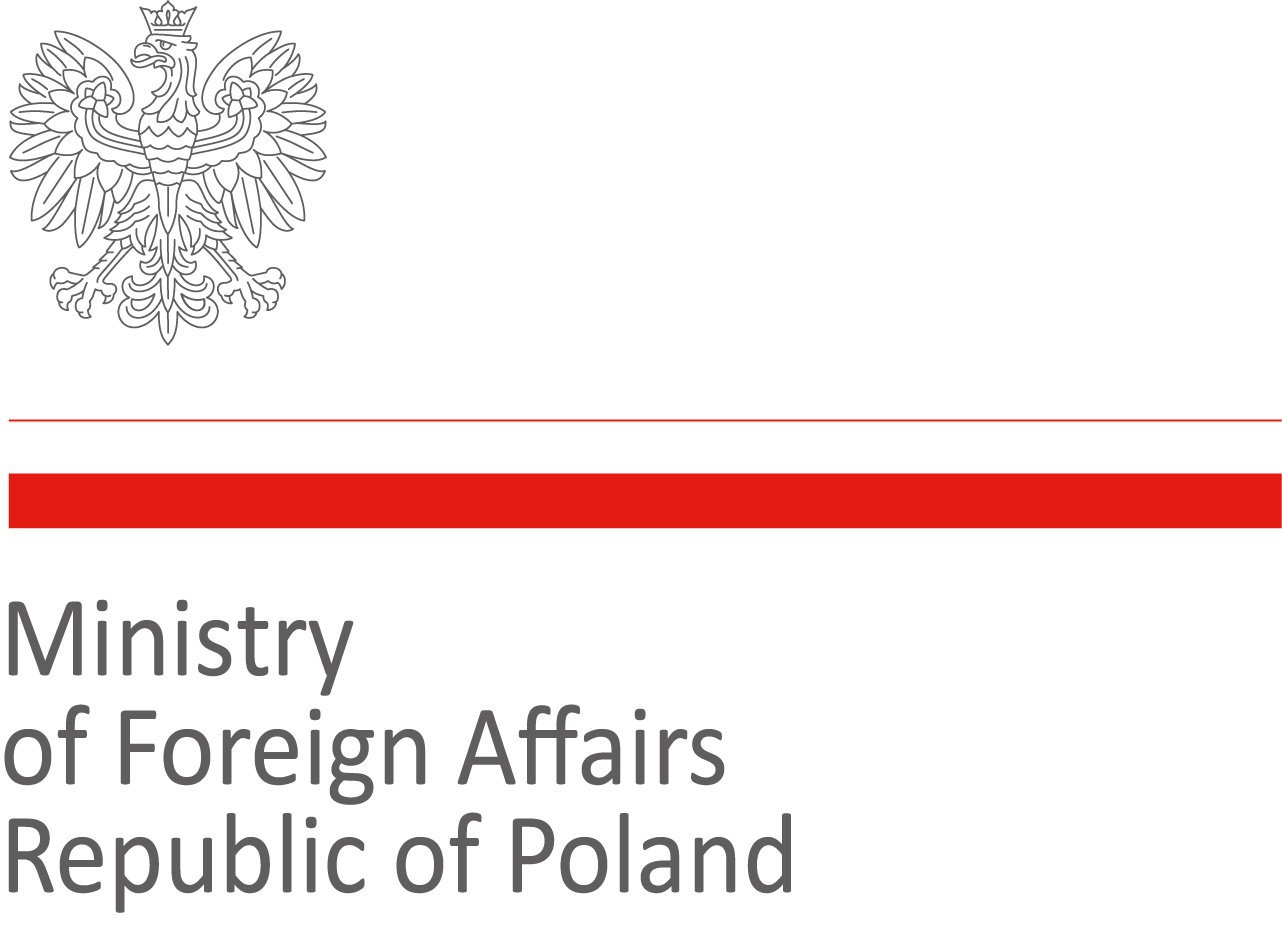 A public task financed by the Polish Ministry of Foreign Affairs as part of Public Diplomacy 2022 (Dyplomacja Publiczna 2022) competition.
A public task financed by the Polish Ministry of Foreign Affairs as part of Public Diplomacy 2022 (Dyplomacja Publiczna 2022) competition.
The contents of this site reflect the views held by the authors and do not constitute the official position of the Polish Ministry of Foreign Affairs.


